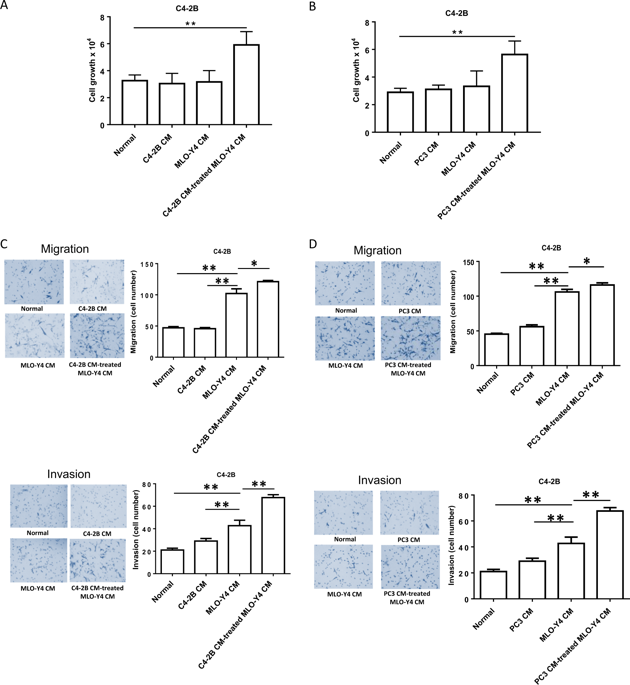Our official English website, www.x-mol.net, welcomes your
feedback! (Note: you will need to create a separate account there.)
Prostate cancer promotes a vicious cycle of bone metastasis progression through inducing osteocytes to secrete GDF15 that stimulates prostate cancer growth and invasion.
Oncogene ( IF 6.9 ) Pub Date : 2019-02-12 , DOI: 10.1038/s41388-019-0736-3 Wenchu Wang 1, 2, 3, 4 , Xin Yang 1, 2, 3, 4 , Jinlu Dai 2 , Yi Lu 5 , Jian Zhang 1, 3, 4, 5 , Evan T Keller 2, 6
Oncogene ( IF 6.9 ) Pub Date : 2019-02-12 , DOI: 10.1038/s41388-019-0736-3 Wenchu Wang 1, 2, 3, 4 , Xin Yang 1, 2, 3, 4 , Jinlu Dai 2 , Yi Lu 5 , Jian Zhang 1, 3, 4, 5 , Evan T Keller 2, 6
Affiliation

|
Bone is the most frequent site of prostate cancer (PCa) metastasis; however, little is known about the role of the most common cell in bone, the osteocyte (OCy), in cancer biology. In this study we explored the crosstalk between PCa cells and OCys to determine if it contributes to PCa progression. PCa cells induced OCys to promote PCa proliferation, migration and invasion. A chemokine screen revealed that PCa cell induced OCys to produce growth-derived factor 15 (GDF15). Knockdown of GDF15 in OCys demonstrated that PCa cells conferred the ability on OCys to promote PCa proliferation, migration and invasion through GDF15. Consistent with this finding was the observation that the GDF15 receptor, GFRAL, was expressed on multiple PCa cell lines. Transcription factor array screening of PCa cells exposed to OCys with or without knockdown of GDF15 revealed that GDF15 in OCys promoted early growth response 1 (EGR1) expression in the PCa cells. Knockdown of EGR1 expression in PCa cells revealed it was required for the OCy-derived GDF15-mediated induction of in vitro PCa cell proliferation, migration and invasion. Subcutaneous co-injection of PCa cells and OCys into mice revealed that OCys promoted tumor growth in vivo, which was diminished by knockdown of GDF15 in the OCys. Knockdown of GDF15 in the tibiae diminished growth of PCa cancer cells injected into the tibiae, which was accompanied by decreased tumor cell proliferation and EGR1 expression. These results shed light on a novel mechanism through which PCa cells educate OCys to promote progression of PCa bone metastasis. They also suggest that targeting of GDF15-based and EGR1-based signaling pathways should be further explored for their potential to diminish progression of PCa bone metastasis.
中文翻译:

前列腺癌通过诱导骨细胞分泌刺激前列腺癌生长和侵袭的 GDF15 促进骨转移进展的恶性循环。
骨是前列腺癌 (PCa) 转移最常见的部位;然而,人们对骨骼中最常见的细胞——骨细胞 (OCy) 在癌症生物学中的作用知之甚少。在这项研究中,我们探讨了 PCa 细胞和 OCys 之间的串扰,以确定它是否有助于 PCa 进展。PCa细胞诱导OCys促进PCa增殖、迁移和侵袭。趋化因子筛选显示 PCa 细胞诱导 OCys 产生生长衍生因子 15 (GDF15)。敲除 OCys 中的 GDF15 表明 PCa 细胞赋予 OCys 通过 GDF15 促进 PCa 增殖、迁移和侵袭的能力。与这一发现一致的是观察到 GDF15 受体 GFRAL 在多个 PCa 细胞系上表达。在有或没有敲除 GDF15 的情况下对暴露于 OCys 的 PCa 细胞进行的转录因子阵列筛选显示,OCys 中的 GDF15 促进了 PCa 细胞中的早期生长反应 1 (EGR1) 表达。PCa 细胞中 EGR1 表达的敲低表明它是 OCy 衍生的 GDF15 介导的体外 PCa 细胞增殖、迁移和侵袭诱导所必需的。将 PCa 细胞和 OCys 皮下共同注射到小鼠体内表明 OCys 在体内促进了肿瘤生长,而 OCys 中 GDF15 的敲低则减少了这种生长。胫骨中 GDF15 的敲低减少了注入胫骨的 PCa 癌细胞的生长,这伴随着肿瘤细胞增殖和 EGR1 表达减少。这些结果揭示了一种新的机制,PCa 细胞通过这种机制教育 OCys 以促进 PCa 骨转移的进展。
更新日期:2019-02-13
中文翻译:

前列腺癌通过诱导骨细胞分泌刺激前列腺癌生长和侵袭的 GDF15 促进骨转移进展的恶性循环。
骨是前列腺癌 (PCa) 转移最常见的部位;然而,人们对骨骼中最常见的细胞——骨细胞 (OCy) 在癌症生物学中的作用知之甚少。在这项研究中,我们探讨了 PCa 细胞和 OCys 之间的串扰,以确定它是否有助于 PCa 进展。PCa细胞诱导OCys促进PCa增殖、迁移和侵袭。趋化因子筛选显示 PCa 细胞诱导 OCys 产生生长衍生因子 15 (GDF15)。敲除 OCys 中的 GDF15 表明 PCa 细胞赋予 OCys 通过 GDF15 促进 PCa 增殖、迁移和侵袭的能力。与这一发现一致的是观察到 GDF15 受体 GFRAL 在多个 PCa 细胞系上表达。在有或没有敲除 GDF15 的情况下对暴露于 OCys 的 PCa 细胞进行的转录因子阵列筛选显示,OCys 中的 GDF15 促进了 PCa 细胞中的早期生长反应 1 (EGR1) 表达。PCa 细胞中 EGR1 表达的敲低表明它是 OCy 衍生的 GDF15 介导的体外 PCa 细胞增殖、迁移和侵袭诱导所必需的。将 PCa 细胞和 OCys 皮下共同注射到小鼠体内表明 OCys 在体内促进了肿瘤生长,而 OCys 中 GDF15 的敲低则减少了这种生长。胫骨中 GDF15 的敲低减少了注入胫骨的 PCa 癌细胞的生长,这伴随着肿瘤细胞增殖和 EGR1 表达减少。这些结果揭示了一种新的机制,PCa 细胞通过这种机制教育 OCys 以促进 PCa 骨转移的进展。











































 京公网安备 11010802027423号
京公网安备 11010802027423号